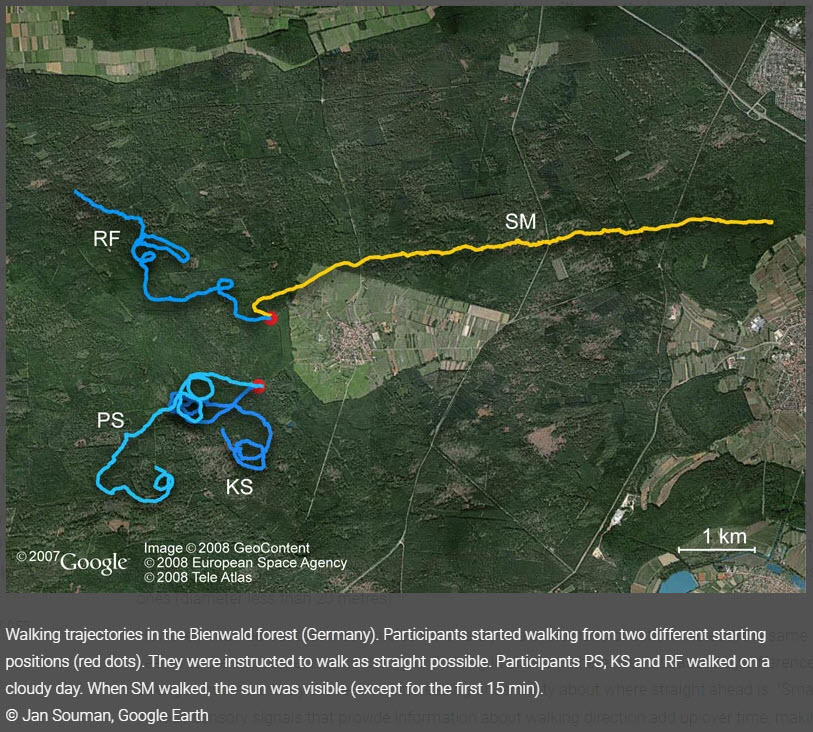What can we learn from the fact that people walk in circles when they get lost in a desert or jungle?
Walking In Circles
Have you ever heard a story about someone getting lost in a blizzard or a sandstorm or a forest and then walking for hours and hours in circles? It’s true! This really happens! In a 2009 study, researchers attached GPS devices to people in the Sahara desert and the Bienwald forest and asked them to walk in a straight line for several hours.
The result? Participants walked in circles! Sometimes, the diameters of their circles were as small as 20 meters! Interestingly, the paths they took were inconsistent. Sometimes they veered in a tight circle to the left, while at other times the same person would meander in a crooked path to the right.
Researchers concluded that “small random errors…. add up over time, making what a person perceives to be straight ahead drift away from the true straight-ahead direction.”
The Power of Landmarks
The researchers explained, “Even though people may be convinced that they are walking in a straight line, their perception is not always reliable.” Can you relate to that? Your intention is clear, your perception is that you are making progress, but… you’re not!
The study reported, “People need….reliable cues….for example a tower or mountain in the distance, or the position of the sun.” Without these landmarks, they’re destined to walk in circles.
Attached to this article is a picture from the study where you can see the paths walked by the participants through the Bienwald forest in Germany. The 3 blue lines were walked by participants on a cloudy day. The yellow line, in contrast, was walked by someone on a day when the sun was covered by clouds for the first 15 minutes, then visible for the rest of the hike. Isn’t it remarkable how straight the yellow line is compared to the blue lines? Everyone was given the same instructions in the same forest. But the only person who managed to walk in a reasonably straight line is the person who could use the sun as a landmark.

My Personal Experience
I learned the power of landmarks as a teenager while driving a tractor to corrugate pastures. In my first attempt, I thought I was driving straight, but when I got to the end of the field and turned around, it looked more like an “S” than a straight line. I was then taught to pick a spot directly across the field and keep the Massey Ferguson emblem on the hood of my tractor on that spot until I got to the other end of the field. It worked!
Application to Leaders and Organizations
Human nature affects all of us all the time. In our individual lives, and in the lives of our organizations, we walk in circles if we don’t have, and use, landmarks! Beware of relying exclusively on your subjective perception.
For example, I’ve seen trucking companies invest a lot of energy into becoming “driver friendly” and “improving safety.” They assign responsibilities, hold meetings, design programs, train employees, and put posters on the walls and stickers on the trucks. I’ve sat in on the leadership meetings and talked to the people responsible for the initiatives. They tell me how hard they’re working and how much they’ve done. I ask, “Are we making progress?” They confidently respond, “Absolutely!” Then I ask, “How do you know? I see the posters and stickers and I know you’ve trained a lot of people, but are we really any safer or more driver friendly than we were before?” They might tell me a story or two about something they heard or saw, but it’s not very convincing. When I do my own research, I’m not convinced anything has really changed. These are good people with good intentions working hard, but at the end of the day, they basically ended up in the same place where they started.
All companies struggle with this, but in my experience, private companies seem to struggle with this at a strategic level more than public ones. Without the discipline and transparency imposed by quarterly earnings reports and regular meetings with boards, shareholders, and analysts, it’s too easy to focus on putting one foot in front of the other without looking up and making sure we’re walking in a straight line.
Suggestions
As I reflect back on these experiences, I have concluded:
- Clear Landmarks: Teams, and individuals, need clear, consistent, specific landmarks. Affirmations alone are not enough. Use metrics whenever possible. Instead of saying, “We need to grow the business and improve profitability”; say, “We need to grow net revenue by 10%+ each year and achieve 20%+ profit margins.”
- Review Regularly: Review your performance against your landmarks on a regular basis. Reflect on what’s working well and what could be improved. Recalibrate and recommit. Leaders need to be doing 1-on-1s with their employees. Annual (or even better, quarterly) reviews aren’t just for employees; teams should have regular reviews too. If you’re the leader of a private company, consider setting up an Advisory Board and meeting with them on a quarterly basis to review performance, develop strategy, and report back on important initiatives.
- Busy vs Productive: Don’t confuse being busy with being productive. Trainings, and posters, and meetings, and projects are important; but don’t let them become the end goal. Force yourself to prove that those efforts are making a difference on the end goal. If they’re not, stop doing those things and try something else.
Do you need help developing clear landmarks or setting up scorecards or an Advisory Board? Give us a call! We have decades of experience and have learned what works and what doesn’t. You can do it. We can help!

